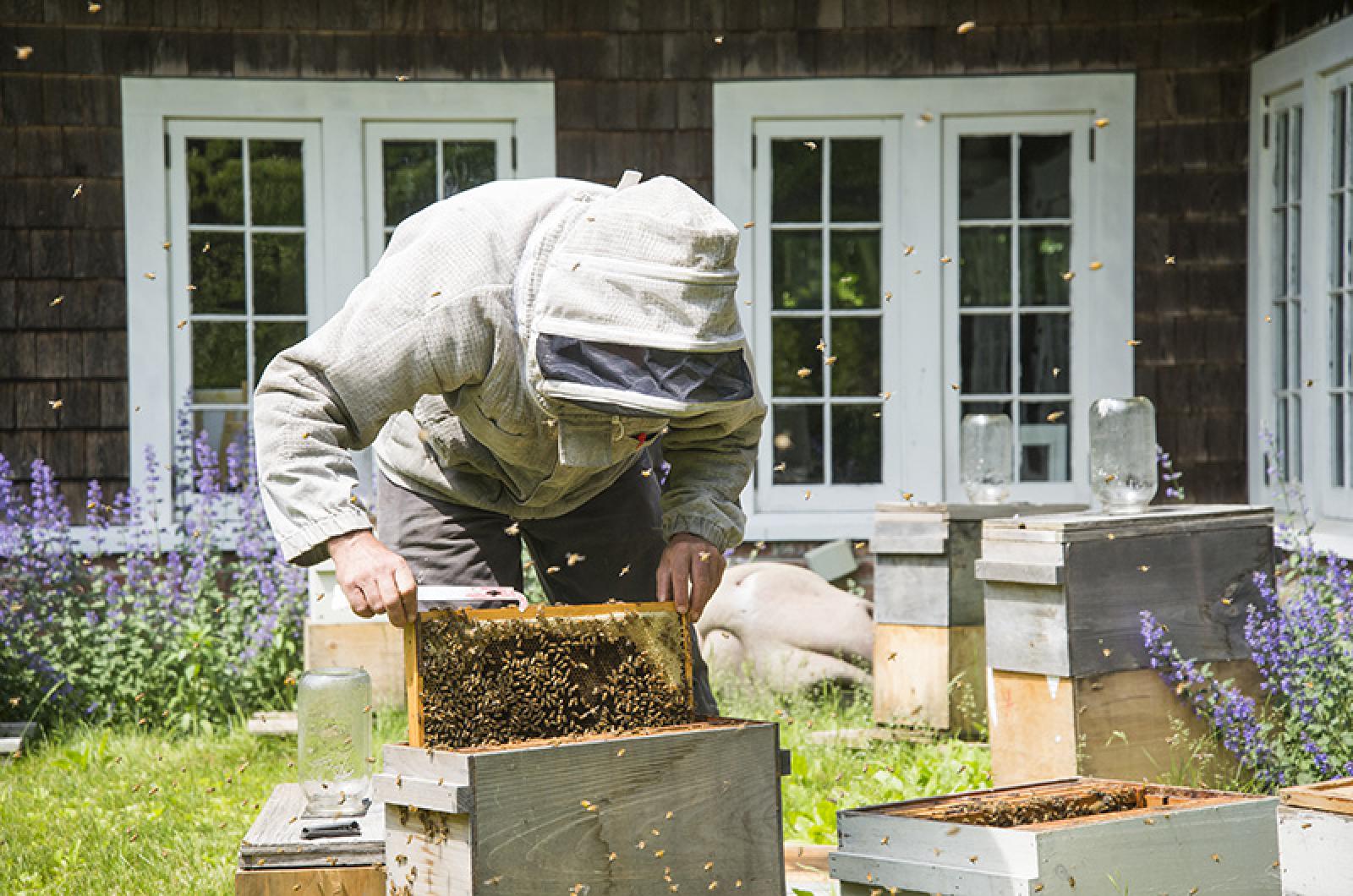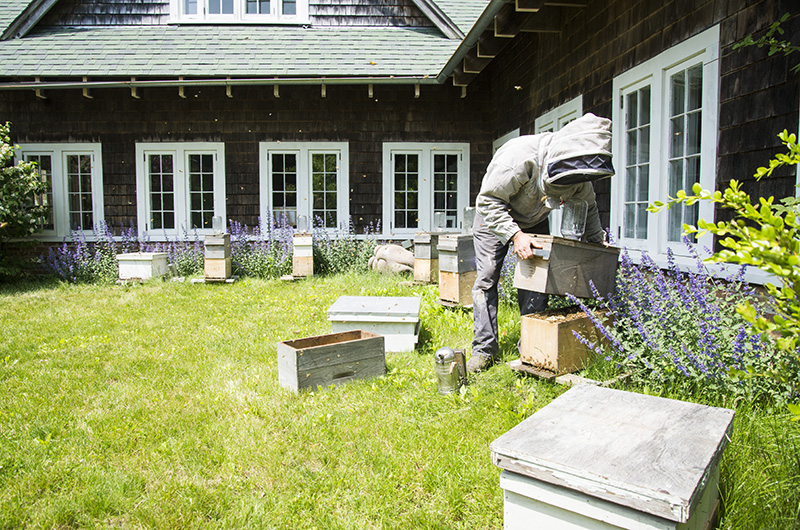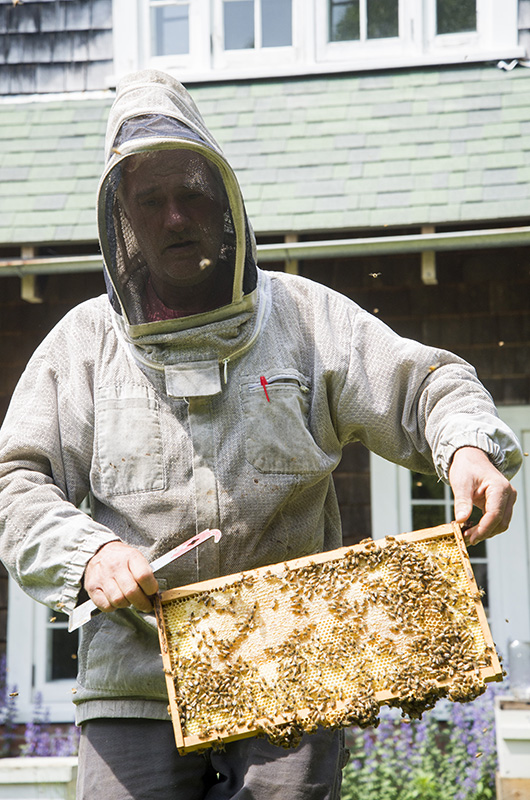Vineyard Haven beekeeper Tim Colon received more calls than usual this year from startled Islanders reporting swarms of bees. A swarm is awe-inspiring to witness: thousands of the furry insects darting around so quickly they seem like an almost solid mass, a deafening buzz thickening the air.
“You won’t believe what I just saw!” callers will report. In fact, Mr. Colon can easily believe it. It is swarming season after all, and Mr. Colon is intimately familiar with the behavior of bees.
“People are so scared, but a swarm is not dangerous at all,” Mr. Colon said. Right before the bees move to a new place, the insects gorge themselves on honey. With a long journey ahead, they don’t know when they will be able to get their next meal. “They’re all fully loaded. They’re sedated,” Mr. Colon said. He estimated he’s gotten 10 calls reporting swarms this year.
Mr. Colon, who owns the Island Bee Company with his wife Tricia, is one of many hobby beekeepers on the Island, raising the European honeybees in wooden boxes in his front and back yard and other places around the Island, collecting the honey which they sell at farmers’ markets and stores. Pulling up a bee frame from a box outside his home, he pointed to the queen, identifiable by her long abdomen.
“She lays between 1,000 and 1,500 eggs per day,” he said. She lives for about three years. Males or drones, meanwhile, die after mating. A young bee’s first job is as a nurse feeding larvae and caring for eggs that have been laid. Next she will become a guard bee, staying near the entrance of the hive to protect it from intruders. Finally, she will become a worker, leaving the hive to collect pollen and nectar from plants in an area around the hive that can have a radius of up to three miles. When the queen dies, bees choose a new larva as her successor, feeding that baby a special substance called royal jelly instead of the usual pollen and nectar. Her special diet allows her to develop the capacity to re produce, unlike her thousands of sterile siblings.
Vineyard naturalist Matt Pelikan said European honeybees arrived on the Island with European humans, and the nonnative species are almost too good at foraging for nectar. He said the competition could be threatening for the bees’ native counterparts.
“Honeybees are wonderful animals, and they’re very useful in agricultural settings, but there is increasing evidence that they compete pretty aggressively against native bees,” Mr. Pelikan said. They are expert coordinators. “A foraging honey bee goes back to the hive and does a particular dance that evidently gives its colleagues direction and distance of a food source.”

It’s called the waggle dance. Bees vibrate their abdomens and move in a figure eight with an direction relative to the position of the sun that very accurately tells others where food is located.
A 2011 study by Paul Goldstein and Russell Hopping identified 130 different species of native bees on the Island using more than 10,000 samples. The study turned up a few remarkable finds including the digger bee, or Anthophora walshii, which had not been previously seen in the Northeast since the 1970s. That bee was found in the state forest.
Mr. Pelikan said the agapostemon virescens, or the bicolored striped sweat bee, is quite common on the Island. The bee has an iridescent green thorax and a striped black and white abdomen. They are ground nesters, and solitary. Unlike honeybees, each female digs her own nest, supplying it with pollen herself and laying eggs. Another species called the cuckoo bee is parasitic, often stealing nests from the agapostemons and laying eggs that will hatch first and eat the rest of the nest’s contents.
Bees aren’t the only pollinators on the Vineyard. Flies, beetles, butterflies, hummingbirds and moths all pitch in.
Felix Neck Wildlife Sanctuary director Suzan Bellincampi is also a beekeeper. She said property owners can do their part to protect pollinators.
“Encourage the right plants. Native plants are always really good,” she said. “And you want some bare soil for solitary bees to nest in.” She added that of course insecticides and herbicides threaten the animals.
Mr. Pelikan too is an advocate for natural yards full of native plants. He said bees also like to live in decaying wood.
“Fragmentation or conversion of habitat into settled areas with low diversity of plants: your basic yard, offers very, very little for any native species,” he said.
Meanwhile, Mr. Colon celebrated the onset of the warm season by dividing his hives Wednesday afternoon, carefully pulling up sheet after sheet of bees and relocating them.
Though there have been lots of swarm reports, this spring has not been an ideal one for honeybees, who don’t like to venture out when it is damp and cold.
“There hasn’t been a lot of great flying time for them,” Mr. Colon said.
He said the flavor of the honey changes over the course of the summer. In June, bees are visiting locust and clover and the honey is lighter. In fall, they use goldenrod, clethera, and Japanese knotweed, yielding a darker golden honey.
He too noted the effect of development on his pollinators.
“The new house down there was built about two years ago,” he said, gesturing down the road. “That used to be all locust trees.”









Comments
Comment policy »